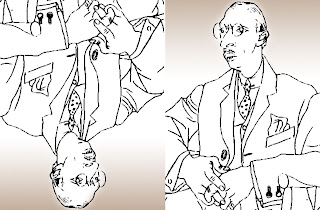
Drawing students had to copy Picasso's drawing of Russian composer, Igor Stravinsky. But they had to do it UPSIDE DOWN. This was to foster better perceptual skills involving edges, spaces, and relationships.
"This puzzle puts L-mode into a logical box: how to account for this sudden ability to draw well, when the verbal mode has been eased out of the task. The left brain, which admires a job well done, must now consider the possibility that the disdained right brain is good at drawing
For reasons that are still unclear, the verbal system immediately rejects the task of "reading" and naming upside-down images. L-mode seems to say, in effect, "I don't do upside down. It's too hard to name things seen this way, and, besides, the world isn't upside down. Why should I bother with such stuff?"
Well, that's just what we want! On the other hand, the visual system seems not to care. Right side up, upside down, it's all interesting, perhaps even more interesting upside down because R-mode is free of interference from its verbal partner, which is often in a "rush to judgment" or, at least, a rush to recognize and name
Why you did this exercise:
The reason you did this exercise, therefore, is to experience escaping the clash of conflicting modes-the kind of conflict and even mental paralysis that the "Vase/Faces" exercise caused. When L-mode drops out voluntarily, conflict is avoided and R-mode quickly takes up the task that is appropriate for it: drawing a perceived image."
Read pp. 57-61 (Above Quote from p.61) in our textbook, Drawing on the Right Side of the Brain; a course in enhancing creativity and artistic confidence by Betty Edwards, © 1999 Tharcher/Putnam















